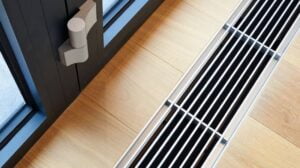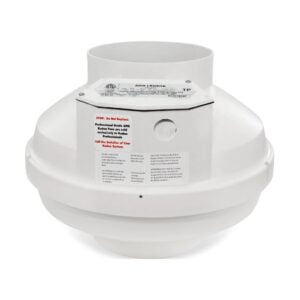CFM, or Cubic Feet per Minute, refers to the volumetric flow rate of a gas or liquid, indicating how much of the substance passes through a certain point over a minute’s time. Therefore, understanding CFM is particularly crucial in the field of pneumatics, where it’s used to quantify the output of air compressors.
The CFM rating directly influences the effectiveness of pneumatic tools, as it signifies the volume of air a compressor can supply. Hence, understanding CFM becomes pivotal when choosing the right pneumatic equipment for certain applications, ensuring they receive the appropriate air volume to operate efficiently.
In application, the CFM is calculated by multiplying the velocity of a fluid in feet per minute (fpm) by its area in square feet. The resulting value is then multiplied by 60 seconds to get the total volume of air flowing through the system per minute. For example, a pneumatic tool with a 3 square inch area and an air velocity of 300 fpm will have a CFM rating of 450.
Q = V x A
Where,
Q = air flow in CFM
V = flow velocity in feet per minute
A = duct cross sectional area
Factors Influencing CFM
- Temperature: The CFM rating is typically measured at a standard reference temperature (68°F or 20°C). As the temperature increases, the air expands, causing the CFM to increase, whereas a decrease in temperature causes the air to contract, resulting in a decrease in CFM.
- Atmospheric Pressure: CFM ratings are generally measured at sea level (14.7 psi) standard atmospheric pressure. Higher altitudes with lower atmospheric pressure result in lower CFM ratings as the air is less dense.
- Humidity: Moisture in the air (humidity) can affect the CFM rating. Higher humidity can increase the CFM because humid air is less dense than dry air. Conversely, lower humidity can decrease the CFM rating as dry air is denser.
Application of CFM in Pneumatic Systems
In pneumatic devices, such as air compressors, the CFM rating is paramount in determining the power and capacity of the tool. For instance, a paint sprayer may require a higher CFM to deliver a steady and consistent spray pattern. On the other hand, a pneumatic nail gun requiring short, intense bursts of power would necessitate a much lower CFM.
In essence, understanding the CFM requirements of different pneumatic tools and equipment aids in optimal operation and ensures the longevity of these tools. When choosing a pneumatic tool, it’s essential to select an air compressor with a CFM rating that matches or exceeds the tool’s CFM requirement. By doing so, you’ll ensure that your equipment operates optimally and to its full potential, leading to improved productivity and efficiency.

Professional Standard Measurements
In a professional setting, anemometers and air flow meters are typically used to measure CFM. Anemometers, which can come in the form of vane or hot-wire anemometers, measure wind speed and can thus calculate CFM when combined with the duct area. Air flow meters, on the other hand, are more sophisticated instruments capable of measuring the volume, velocity, and pressure of the airflow, providing a direct CFM reading.
These tools are highly accurate and reliable and are often used by HVAC professionals and engineers who require precise measurements for critical applications. They are calibrated regularly to maintain their accuracy and can handle varying conditions of pressure, humidity, and temperature.
Home Measurements
For home measurements or non-critical applications, a simpler method can be employed using commonly available tools. This involves measuring the air speed using a simple handheld anemometer and then calculating the CFM using the formula: CFM = Air Speed (in feet per minute) x Area (in square feet).
While this method may not offer the same level of precision as professional standard measurements, it can provide a reasonably accurate estimation of CFM, suitable for general home applications such as setting up HVAC systems, fans, or other air-moving devices. It’s important to remember that the accuracy of this method largely depends on the precision of your measurements and the consistency of the air flow.
The Relationship Between CFM and Energy Efficiency

The CFM (Cubic Feet per Minute) value of an air-moving device has a direct impact on its energy consumption and overall efficiency. Generally, devices with a higher CFM value consume more power as they move greater volumes of air per minute. However, the key to achieving energy efficiency is not necessarily using a device with a lower CFM but rather optimizing the CFM for specific requirements.
For instance, an HVAC system or a fan running at a higher CFM than necessary will consume more energy without significantly improving comfort levels. On the contrary, an underperforming system with a low CFM might not adequately condition the space, leading to longer run times and higher energy consumption over time. Therefore, it’s essential to balance and optimize CFM based on the needs of the space, which includes factors such as its size, occupancy, and the specific cooling or heating requirements.
By maintaining the optimum CFM, it’s possible to enhance both the performance and the energy efficiency of the air-moving device. This not only leads to potential cost savings on energy bills but also contributes to a more sustainable and environmentally friendly operation.
Conclusion
The CFM value is an important measure for determining the performance of air-moving devices and their energy efficiency. By understanding CFM , the relationship between CFM and energy efficiency, it’s possible to optimize the CFM for specific requirements and achieve a balance between comfort levels and energy consumption.
This ultimately leads to a more efficient, sustainable, and cost-effective operation for homes and buildings. So, it’s essential to carefully consider the CFM value when selecting or setting up air-moving devices in order to achieve optimal results.

